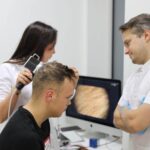Many people ask whether wearing a hat, bike helmet, or work helmet can contribute to hair loss. These doubts arise especially during periods when head coverings are worn daily – in winter, while playing sports, at work, or when riding a motorcycle. A common belief is that tight-fitting hats limit the flow of air to the scalp, making hair weaker and causing shedding. But is there really anything to worry about?
Scalp hypoxia – myth or reality?
One popular argument is the claim that hats or helmets “suffocate” the scalp, leading to oxygen deprivation. It’s important to clarify that the skin, including the scalp, does not breathe the way our lungs do. Oxygen is delivered to hair follicles through blood vessels, not from the surrounding air. Therefore, wearing head coverings does not directly affect oxygen access to hair roots. Moreover, helmets or hats do not compress blood vessels in a way that would disturb their function – provided they are well-fitted and made from proper materials.
| Myth / Concern | Medical truth |
|---|---|
| A hat restricts oxygen supply | The scalp receives oxygen from blood, not from air |
| Helmets cause baldness | Only very tight, long-term use could cause mechanical follicle damage |
| Hats make hair greasy | This is due to poor ventilation, synthetic fabrics, and improper care |
| Unlined hats are better | The key factor is the material: breathable, natural, soft |
Friction, heat, and moisture – factors that may worsen hair condition
Although wearing a hat does not cause baldness, prolonged use of ill-fitting or synthetic head coverings can lead to certain negative effects. Friction between the fabric and the scalp can mechanically damage hair, especially if hair is thin, brittle, and weak. At the same time, hats often create a warm and humid environment that promotes the growth of bacteria and fungi such as Malassezia – responsible, among other things, for worsening seborrheic dermatitis, which may contribute to increased hair shedding.
Mechanical hair loss – when it can really happen
Medicine recognizes cases of traction alopecia, which occurs as a result of prolonged, strong tension on the hair. It usually affects people who regularly wear very tight hairstyles – such as braids, buns, or ponytails. Theoretically, a very tight helmet worn for many hours a day could cause a similar effect in pressure points. However, this refers to exceptional cases where an uncomfortable, poorly fitted helmet is worn daily for months without breaks. In everyday use, there is little risk of hair loss caused solely by head coverings.

According to survey data, 69.6% of people believe that wearing headscarves or head coverings promotes hair loss (PMC). However, there is no clear scientific evidence to support this hypothesis.
A hat doesn’t cause baldness – but it may reveal it
Patients often notice increased hair shedding during autumn and winter, when they wear hats. This can lead to the false conclusion that the hat itself is causing the problem. In reality, the natural hair growth cycle includes periods of more intense shedding – for example, in autumn and early spring – and this is usually the real cause. A hat only makes falling hairs more noticeable – it’s easier to spot them on fabric than on a pillow or clothing. In such cases, it is worth focusing not on the hat but on overall health – vitamin levels, hormonal balance, or stress. It’s also important to know that hormones strongly influence hair condition. See which hormones to test in case of hair loss.
“It’s not the hat, but hormonal imbalance or stress that most often cause hair loss – it’s worth diagnosing the cause, not masking the symptom.”
— Dr Piotr Turkowski
How to care for hair if you wear a helmet or hat daily?
People who, due to work conditions or sports, wear helmets or hats every day should follow a few key care principles. Most importantly, choose head coverings made of natural, breathable materials that minimize the risk of scalp overheating. After each day, it is advisable to thoroughly wash the scalp with a gentle shampoo to remove excess sebum and impurities. Proper scalp care (such as moisturizing tonics or plant-based scalp serums) can significantly improve microcirculation and support natural hair growth.
For those prone to seborrhea or dandruff, regular scalp cleansing and, if necessary, trichological products are important. It is also worth maintaining a diet rich in zinc, iron, biotin, and B vitamins – deficiencies in these nutrients often manifest as deteriorating hair and scalp condition. If concerning symptoms such as thinning hair, scalp flaking, or itching occur, it is advisable to consult a trichologist or scalp health specialist.
Hair loss is a complex process – the hat isn’t always to blame
It is important to emphasize that hair loss is a multifactorial process, with underlying causes such as genetic predisposition, hormonal imbalances, chronic stress, poor diet, scalp conditions, or the effects of certain medications. In such cases, wearing a hat or helmet is not the cause of hair loss but a factor that may only worsen it if hygiene and care are neglected.
It should be remembered that androgenetic alopecia – the most common type of hair loss in men – develops regardless of external factors. It is linked to follicle sensitivity to dihydrotestosterone (DHT). Similarly, telogen effluvium, which typically appears a few weeks after a stressful event or infection, is also unrelated to wearing hats. Blaming head coverings distracts from the real causes, which often require diagnostics and a holistic approach.
If you notice visible thinning, receding hairlines, or bald spots on the crown, don’t delay seeking a consultation. Early diagnosis of the type of hair loss provides more treatment options and allows for planning an individualized regrowth program. A specialist evaluation of the scalp, trichological analysis, and laboratory tests can provide crucial information that cannot be diagnosed “by eye” or with home methods. At Piotr Turkowski’s Clinic, we treat each patient individually – analyzing not only the condition of their hair but also lifestyle, nutrition, genetic factors, and overall health.




